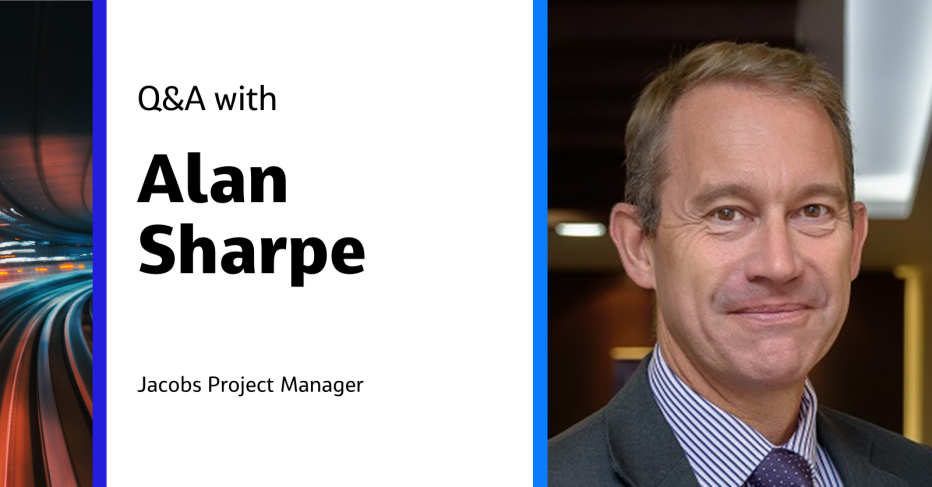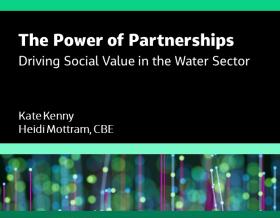
Public transportation systems, valued as some of the most equitable and sustainable modes of transportation, connect communities and help stimulate economic development.
Expanding these complex systems and adding more advanced solutions, such as high-speed rail, to meet public demand can be an intricate, high-intensity ride. Whether the journey includes keeping pace with capacity building and accelerating technology innovations, ensuring safety and security or maintaining transport networks, Jacobs is on board to serve all aspects of high‐speed and conventional passenger rail, freight and logistics, mass/public transit and innovative bus solutions.
We’re a globally recognized leader in the safe and efficient delivery of rail and transit solutions – from planning, design and development to delivery and management.
In this Q&A, we connect with one of our global teammates, Project Manager Alan Sharpe, to discuss trends and technology shaping transportation of tomorrow.
Tell us a bit about your background and how it shapes your approach.
I’ve had the opportunity to work on several major, prestigious projects in various locations across the world. Through this global experience, I’ve have learned to be adaptable and to tailor my way of working to fit into a variety of working relationships, technical differences and stakeholder groups.
This global approach means I not only bring my projects technical knowledge in areas like rail structures, cable stayed bridges, highways and the interaction of design components; but also experience managing high-performing teams to deliver programs and work collaboratively with all stakeholders.
What are the biggest challenges in rail & transit?
With the global attention on sustainability and the need for a global collaboration to counteract increased carbon emissions, there’s a greater focus on public transport and development of more sustainable forms of transport. Although rail produces far fewer emissions than air and road, one challenge in rail and transit is the need to constantly consider sustainability initiatives as we develop our global networks. The rail industry will require continuous investment and funding to deliver economic benefits, support changing customer needs, meet digitalization and decarbonization targets, and grow the sector. Only by investing in the industry will we increase capacity, support growth and reduce costly service outages – leading to more reliable networks.
Another challenge facing the industry is the affordability of maintaining existing networks and proving sound business cases for new lines, given the increasing cost of materials and often adverse public perceptions to the high costs associated with new rail networks. Although government and railway companies continue to invest in improving our rail networks, there’s still a significant funding gap that requires investment.
How do you help clients think differently to respond to future challenges?
By leveraging technology with innovations in digital systems, we can look to reduce operational costs, improve mobile connectivity, and station developments to boost passenger comfort to encourage passengers to return to rail as a primary mode of transportation. Other challenges facing the industry include inflation, rising ticket costs, ongoing strikes, service disruptions and delays – all of which can deter passengers from choosing rail as their means of transport. With the biggest source of revenue stream through ticket sales, we must look to strengthening the attractiveness of the railways by improving passenger comfort, reliability and connectivity.
As we look to develop the rail network for the future, we must rely on engineers and technologists to find innovative solutions to improve efficiencies and make rail transport more affordable and more connected. Examples of what our subject matter experts can provide include data analysis and remote condition monitoring. By increasing data services, engineers can determine where issues are occurring and focus on solving those challenges. This will not only improve safety but will decrease costs and help reduce travel-related environmental impacts.
With more than one million people expected to call Seattle home by 2044, what’s a trend you’re seeing in the Seattle area lately?
Linking communities through light rail and reducing the demand on car journeys has caused a rise in light rail and transit links around the world. Within the Seattle area, there’s an opportunity to link communities through extensions of its light rail network and to expand the light rail to a community that is currently relying on vehicles to connect to the city.
You mentioned technology, how do you see data solutions changing how we deliver transportation solutions going forward?
Technology is developing quickly, through communication platforms, data collection and storage, design tools and the development of artificial intelligence (AI) and robotics. We’ve seen the development from 2D digital drawings through BIM and the creating of digital twins for major infrastructure projects. With so much development, there are great opportunities to streamline design and ensure data is collected and stored with long-term asset management. Health and safety through design and construction will be paramount. It's imperative to consider safe ways to collect data through design, construction and long-term maintenance and security.
What are some lessons learned from successful delivering mega rail & transit projects?
There are many factors associated with the successful delivery of large rail and transit projects. With each delivery experience, there are lessons learned that can be applied to the next project.
First, collaboration is key. Collaboration is a holistic concept that includes early contractor involvement so that all aspects of construction methodology and logistics are included in planning. This can take time to evolve, and methods should be adopted to bring parties together through induction and teaming. It’s imperative that teammates work together to establish an open dialogue – from inception through design development. Genuine and clear communication is key for teams to understand requirements, resolve integration issues and ensure compliance and constructability.
Also, establishing a team structure is essential. Early understanding of the project nuances is required as late information will impact major design elements. Also, third-party approvals are critical to staying on schedule. The best way to achieve this is to set the stage with communication protocols, submission plans and delivery requirements to share design development and align on needs and demands. For example, I once led an exclusive team where teammates were assigned based on their previous experience working with the third parties. This way we built on existing relationships to enable first time approvals to submissions.
Is there a project you're particularly proud of?
A project I am proud of was a fast-track final design-build contract in Dubai. The project had complex design interfaces, which required efficient design and close collaboration between the design team, contractor and owner to ensure delivery for a set deadline. To establish collaboration between the teams, it was important for all entities to work with a common goal to deliver on time and within budget, to keep the stakeholders informed and to enable swift resolution of challenges.
One of the most important aspects of a program like this is to build TRUST. Trust is essential to build a high performing team that can seamlessly work with the client and stakeholders. In addition to trust, understanding the client’s concerns and goals at the early stages is fundamental in setting the direction for the team. I have seen many challenges within major projects including construction logistics, impact on local communities, along with technical nuances such as rail structure interaction and cable stayed bridge construction – not to mention the interpersonal necessities, such as building teams, personality clashes and ensuring effective communications among all parties.
About the interviewee

While Alan Sharpe’s 37 years of success leading $10 billion transportation mega programs around the world is admirable, what’s more impressive is his ability to cultivate a culture of transparency and trust. Honesty, humility, intent listening and keen powers of observation are the active ingredients of his leadership style. A strong advocate of collaboration, his management philosophy is “if we all work together to develop the project in the best, most efficient way, everybody will win.” The best way to achieve this, he says, is finding a common goal everyone can share on the project.
In addition to his management credentials, Alan also brings a strong technical background. Having started his career as a bridge engineer, he’s worked on the designs for several cable-stay bridges and guideway structures and written software for conducting structural analysis. As a result, he understands the fundamentals of design and often uses that knowledge to challenge technical staff to consider more optimal methods or tools. He also likes to impart some of his nearly 40 years of accumulated knowledge and enjoys mentoring the next generation of thinkers and doers.
Alan’s experience spans all modes of transportation, including rail, bridges, and highways, as well as complex structures such as cable-stay bridges, twin-bored tunnels and passenger rail expansions. He says his favorite part of his role is the buzz of working as a team and the collective excitement of delivery where everyone feels they’re equally represented, are facing challenges together and have pride in the delivery of amazing pieces of infrastructure that will be a become a legacy all can be proud of.

















































